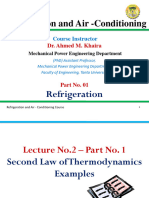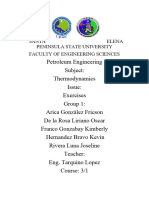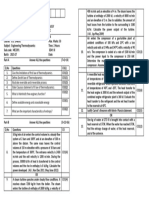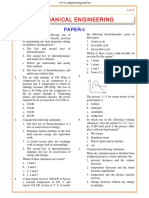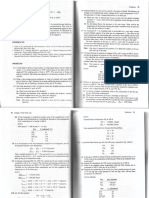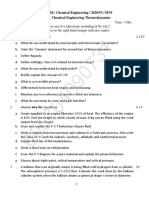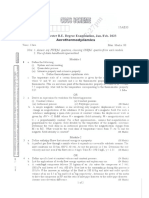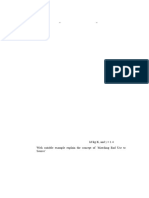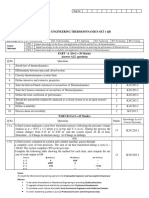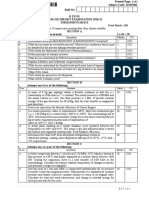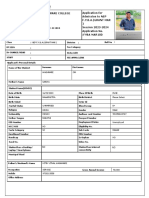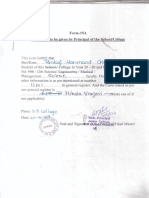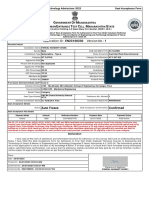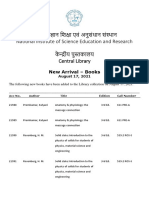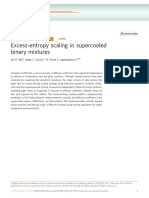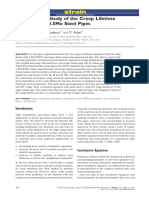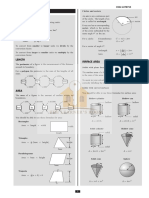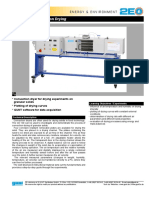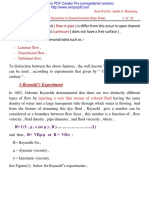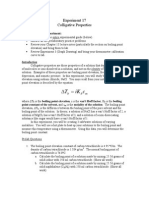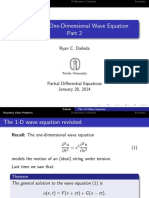0 ratings0% found this document useful (0 votes)
8 viewsAssignment 2
Assignment 2
Uploaded by
Pankaj GhugeThermodynamics 2
Copyright:
© All Rights Reserved
Available Formats
Download as DOCX, PDF, TXT or read online from Scribd
Assignment 2
Assignment 2
Uploaded by
Pankaj Ghuge0 ratings0% found this document useful (0 votes)
8 views2 pagesThermodynamics 2
Copyright
© © All Rights Reserved
Available Formats
DOCX, PDF, TXT or read online from Scribd
Share this document
Did you find this document useful?
Is this content inappropriate?
Thermodynamics 2
Copyright:
© All Rights Reserved
Available Formats
Download as DOCX, PDF, TXT or read online from Scribd
Download as docx, pdf, or txt
0 ratings0% found this document useful (0 votes)
8 views2 pagesAssignment 2
Assignment 2
Uploaded by
Pankaj GhugeThermodynamics 2
Copyright:
© All Rights Reserved
Available Formats
Download as DOCX, PDF, TXT or read online from Scribd
Download as docx, pdf, or txt
You are on page 1of 2
Marathwada Mitra Mandal’s
College of Engineering,
Karvenagar, PUNE - 411 052
Department of Mechanical Engineering
Class : Second Year
Subject : Engineering Thermodynamics
Assignment 2
Ideal Gas and Second Law of Thermodynamics
Sr. No. Question BL
1 What is the difference between a refrigerator and a heat pump 1
Define the coefficient of performance of a refrigerator. Can it be 2
2
greater than unity?
Define Kelvin Planks and Clausius statements of second law of
3 2
thermodynamics
Prove the equivalence of Kelvin Planks and Clausius 2
4
statements of second law of thermodynamics
A household refrigerator with a COP of 1.2 removes heat from the
refrigerated space at a rate of 60 kJ/min. Determine (a) the electric 3
5
power consumed by the refrigerator and (b) the rate of heat
transfer to the kitchen air. (Answers:(a) 0.83 kW, (b) 110 kJ/min)
A refrigerator has a COP of 1.5. That is, the refrigerator removes 1.5
kWh of energy from the refrigerated space for each 1 kWh of
6 3
electricity it consumes. Is this a violation of the first law of
thermodynamics? Explain.
A heat pump that is used to heat a house has a COP of 2.5.
That is, the heat pump delivers 2.5 kWh of energy to the house
7 3
for each 1 kWh of electricity it consumes. Is this a violation of
the first law of thermodynamics? Explain.
8 Define the laws applicable for ideal gas. 2
What is difference between Universal gas constant and 2
9
characteristic gas constant?
Derive the following equations for an ideal gas undergoing isobaric
10 process Work done, Heat Transfer, change in entropy, Change in
2
internal energy.
Derive an expression for work transfer in a reversible adiabatic 2
11
process. Draw P-V and TS diagram.
12 1 kg of air at a pressure of 8 bar and a temperature of 1000 C 2
undergoes a reversible polytropic process following the law PV 1.2 =
C. If the final pressure is 1.8 bar. Determine: (i) The final specific
volume, temperature and increase in entropy; (ii) The work done
and the heat transfer. Assume R=0.287 kJ/kgK and γ=1.4.
A gas occupies a volume of 0.1 m 3 at a temp of 20°C and a press of
13 1.5 bar. Find the final temp of the gas if it is compressed to a press
3
of 7.5 bar and occupies a volume of 0.04 m3. (586K)
You might also like
- Assignment 1 & 2Document17 pagesAssignment 1 & 2Iyyan Paramanandam67% (3)
- Problems Part2Document21 pagesProblems Part2Sharif Mohd Zaki100% (1)
- Etd QB Set 2Document2 pagesEtd QB Set 2srinithims78No ratings yet
- Solve Sheet 1Document26 pagesSolve Sheet 1joelshiekh9No ratings yet
- Example 6Document3 pagesExample 6ScribdTranslationsNo ratings yet
- ME3391 - Engineering ThermodynamicsDocument1 pageME3391 - Engineering ThermodynamicsSiva RamanNo ratings yet
- Etd Cia-I 50 MarksDocument2 pagesEtd Cia-I 50 MarksSRCE MECHANICALNo ratings yet
- Homework #2 For Chemical Engineering ThermodynamicsDocument1 pageHomework #2 For Chemical Engineering Thermodynamicsramesh pokhrelNo ratings yet
- Soal PR TermodinamikaDocument10 pagesSoal PR TermodinamikaanjaniNo ratings yet
- Tut 1Document12 pagesTut 1fakuluvuyo25No ratings yet
- QB Te5101 Unit1Document1 pageQB Te5101 Unit1Dr.T.ChristopherNo ratings yet
- Chapter 5Document1 pageChapter 5Train DiskenthNo ratings yet
- IES-OBJ-Mechanical Engineering-2000 Paper-I PDFDocument15 pagesIES-OBJ-Mechanical Engineering-2000 Paper-I PDFAnonymous TedqS0h6ZkNo ratings yet
- Ps 1Document9 pagesPs 1Maulana ArifNo ratings yet
- HMT QBDocument7 pagesHMT QBmithulsharon11No ratings yet
- Ies Mech TotaDocument158 pagesIes Mech TotaVara PrasadNo ratings yet
- 2023 MteDocument6 pages2023 MteISHAAN JAIN 22114039No ratings yet
- Thermodynamics Tutorial - QuestionsDocument11 pagesThermodynamics Tutorial - Questionsdinalamin195No ratings yet
- MEG 212 Practise QuestionsdocxDocument11 pagesMEG 212 Practise Questionsdocxoyetunde ridwanNo ratings yet
- Assignment Cum Class Test 1 Module 1Document2 pagesAssignment Cum Class Test 1 Module 1yogendra kumarNo ratings yet
- SE - 2019 Engineering ThermodynamicsDocument4 pagesSE - 2019 Engineering ThermodynamicsYash PawarNo ratings yet
- Ragone - Enunciados Problemas (Cap. 1 A 5)Document14 pagesRagone - Enunciados Problemas (Cap. 1 A 5)LucioNo ratings yet
- HW07 Ch07 2nd Law CarnotDocument3 pagesHW07 Ch07 2nd Law Carnotabdoag1691998No ratings yet
- Assignment 2Document2 pagesAssignment 2Lovish ChopraNo ratings yet
- TH4 - ChemicalEngineeringThermodynamics - New SyllabusDocument2 pagesTH4 - ChemicalEngineeringThermodynamics - New SyllabusSatvik BeheraNo ratings yet
- Basic Thermodynamics - CompressedDocument41 pagesBasic Thermodynamics - Compressedaffiya fathimaNo ratings yet
- UNIT-1Basic Concepts: Subjec T: ET (3131905)Document14 pagesUNIT-1Basic Concepts: Subjec T: ET (3131905)shubhpatel.svmrNo ratings yet
- ET - 3131905 - 3rd SEM - BEDocument8 pagesET - 3131905 - 3rd SEM - BESandesh BiradarNo ratings yet
- Co1 PS PDFDocument2 pagesCo1 PS PDFanon_476594787No ratings yet
- CIADocument2 pagesCIAMr. Jerome Nithin GladsonNo ratings yet
- Z. H. Sikder University of Science & Technology: Answer Any Two (02) of The Following Questions From Individual PartDocument2 pagesZ. H. Sikder University of Science & Technology: Answer Any Two (02) of The Following Questions From Individual PartRakibul Hasan SarkerNo ratings yet
- 7157902Document62 pages7157902Red RedNo ratings yet
- 15AE33 JAN FEB 23-1 (2 Files Merged)Document2 pages15AE33 JAN FEB 23-1 (2 Files Merged)bhargavNo ratings yet
- Correlation Lecture Mesl 02 Thermodynamics Fluid MechanicsDocument4 pagesCorrelation Lecture Mesl 02 Thermodynamics Fluid Mechanicsjustinegabuya82No ratings yet
- Me3391-Engineering Thermodynamics-805217166-Important Question For Engineering ThermodynamicsDocument10 pagesMe3391-Engineering Thermodynamics-805217166-Important Question For Engineering ThermodynamicsRamakrishnan NNo ratings yet
- Gujarat Technological UniversityDocument2 pagesGujarat Technological Universitymanav.m25225No ratings yet
- Tutorial 4 - Carnot and Introduction To EntropyDocument4 pagesTutorial 4 - Carnot and Introduction To EntropyasdfsdjhNo ratings yet
- ETD Assignment 1Document4 pagesETD Assignment 1ragunath LakshmananNo ratings yet
- Notes 02Document12 pagesNotes 02PrashantNo ratings yet
- CHAPTER 6-Second Law of ThermodynamicsDocument29 pagesCHAPTER 6-Second Law of ThermodynamicsAbuzar AliNo ratings yet
- Combus Eng'g Homework 1Document5 pagesCombus Eng'g Homework 1Alecsia NuguidNo ratings yet
- U114323 PDFDocument3 pagesU114323 PDFThaanya sNo ratings yet
- W18 2722112 EATSDocument2 pagesW18 2722112 EATSStream stuffNo ratings yet
- Thermo Final 2Document2 pagesThermo Final 2diresilignbereketNo ratings yet
- Etd QB Set1Document3 pagesEtd QB Set1srinithims78No ratings yet
- 05-1-Collection of Problems PDFDocument15 pages05-1-Collection of Problems PDFFistia MaulinaNo ratings yet
- Work Sheet1Document4 pagesWork Sheet1Tesfa negaNo ratings yet
- BE Chemical MBA+FT 4 Semester Chemical Engineering Thermodynamics First PeriodicalsDocument2 pagesBE Chemical MBA+FT 4 Semester Chemical Engineering Thermodynamics First PeriodicalsAditya KumarNo ratings yet
- AssimentDocument3 pagesAssimentSantosh SharmaNo ratings yet
- Problem Set 2 For All The Problems State The Assumptions You Consider ClearlyDocument2 pagesProblem Set 2 For All The Problems State The Assumptions You Consider ClearlychandrahasNo ratings yet
- Btech Thermodynamics - 2021Document2 pagesBtech Thermodynamics - 2021Shailesh Singh SuryavanshiNo ratings yet
- 9D17101 Advanced ThermodynamicsDocument1 page9D17101 Advanced ThermodynamicssubbuNo ratings yet
- Cet 8th Edition Unit 2 Solution PDFDocument78 pagesCet 8th Edition Unit 2 Solution PDFJUAN PABLO AREVALO FERNANDEZ100% (1)
- Thermodynamics Lecture 6Document1 pageThermodynamics Lecture 6Mariah NicolNo ratings yet
- Question Bank Thermal Engineering UPDATEDDocument6 pagesQuestion Bank Thermal Engineering UPDATEDIrfan ShaikhNo ratings yet
- Assignment 3Document3 pagesAssignment 3happy20212025No ratings yet
- Problems and Solutions: Physical ChemistryDocument179 pagesProblems and Solutions: Physical ChemistryRialeeNo ratings yet
- A Modern Course in Statistical PhysicsFrom EverandA Modern Course in Statistical PhysicsRating: 3.5 out of 5 stars3.5/5 (2)
- Application061320231221581231686639118123.4855 4432812Document9 pagesApplication061320231221581231686639118123.4855 4432812Pankaj GhugeNo ratings yet
- ED-2023-00939284 Form 15 Certi School CollDocument1 pageED-2023-00939284 Form 15 Certi School CollPankaj GhugeNo ratings yet
- All India Provisional Merit ListDocument7,037 pagesAll India Provisional Merit ListPankaj Ghuge0% (1)
- Ed 2023 00939284 - PankajDocument7 pagesEd 2023 00939284 - PankajPankaj GhugeNo ratings yet
- .. - State Common Entrance Test Cell, Government of Maharashtra - ..Document2 pages.. - State Common Entrance Test Cell, Government of Maharashtra - ..Pankaj GhugeNo ratings yet
- ASTM A275-A275M-15 Magnetic Particle Examination of Steel ForgingsDocument7 pagesASTM A275-A275M-15 Magnetic Particle Examination of Steel ForgingsDiego Egoávil Méndez100% (3)
- New Arrivals 17 - 08 - 2021Document16 pagesNew Arrivals 17 - 08 - 2021polar necksonNo ratings yet
- Excess-Entropy Scaling in Supercooled Binary MixturesDocument12 pagesExcess-Entropy Scaling in Supercooled Binary MixtureslgustavolucaNo ratings yet
- Ook Eview: Lattice Boltzmann Method: Fundamentals and Engineering Applications With Computer CodesDocument2 pagesOok Eview: Lattice Boltzmann Method: Fundamentals and Engineering Applications With Computer CodesjoshuaNo ratings yet
- Stress Strain Curve-1Document5 pagesStress Strain Curve-1AsadNo ratings yet
- A Guide To Experimental Particle Physics Literature 1994-1998Document453 pagesA Guide To Experimental Particle Physics Literature 1994-1998Chris Ioannou GksNo ratings yet
- Pu 54 421Document8 pagesPu 54 421Lubna FurqanNo ratings yet
- CH 15 Transmission of HeatDocument53 pagesCH 15 Transmission of HeatCat123No ratings yet
- Application of User Defined Subroutine U PDFDocument58 pagesApplication of User Defined Subroutine U PDFmatmean100% (2)
- Experimental Study of The Creep Lifetime of The 1.25Cr 0.5mo Steel PipesDocument7 pagesExperimental Study of The Creep Lifetime of The 1.25Cr 0.5mo Steel PipesMiguel Angel RebolloNo ratings yet
- 2 BAA3513 Lateral Earth Pressure (Part 2)Document42 pages2 BAA3513 Lateral Earth Pressure (Part 2)احمد يوسفNo ratings yet
- Mensuration FormulasDocument2 pagesMensuration FormulashayaNo ratings yet
- Ce 130Document2 pagesCe 130Mayito GarófaloNo ratings yet
- CE272 Fluid MechanicsDocument56 pagesCE272 Fluid MechanicsHasan KırmızıoğlanNo ratings yet
- NTU MG5 Lectures PDFDocument209 pagesNTU MG5 Lectures PDFadsdasdassadsadNo ratings yet
- (Flow in Pipe) A Pressure: 1-Reynold's ExperimentDocument21 pages(Flow in Pipe) A Pressure: 1-Reynold's Experimentnurul athirahNo ratings yet
- GAAN Lab Procedure Final-2010Document4 pagesGAAN Lab Procedure Final-2010subramaniyam.ek28210% (1)
- Buffer Calculations Deceive and ObscureDocument8 pagesBuffer Calculations Deceive and ObscureJonathanNo ratings yet
- CBSE+10+Umang +Electricity+in+One+ShotDocument106 pagesCBSE+10+Umang +Electricity+in+One+Shotnishant0% (1)
- Analyze Transmission Lines With Almost No MathDocument5 pagesAnalyze Transmission Lines With Almost No MathCARROUCHO62No ratings yet
- Iffco Trainin ReportDocument55 pagesIffco Trainin ReportAman Bhatia75% (4)
- Solving The One-Dimensional Wave Equation: Ryan C. DailedaDocument23 pagesSolving The One-Dimensional Wave Equation: Ryan C. Dailedabaraa AlkhaqaniNo ratings yet
- Chapter 1Document21 pagesChapter 1tilayeyidegNo ratings yet
- Photoelectric Effect - Abstrak KLPK 2-3Document4 pagesPhotoelectric Effect - Abstrak KLPK 2-3Yunita Puspa AnggreniNo ratings yet
- Question Paper Code:: Reg. No.Document3 pagesQuestion Paper Code:: Reg. No.Nithiya MaharajanNo ratings yet
- Lightning Protection Analysis of LRT DC OCSDocument9 pagesLightning Protection Analysis of LRT DC OCSnbashir786No ratings yet
- Construction Mechanics Basic Volume 2Document441 pagesConstruction Mechanics Basic Volume 2Veikko212No ratings yet
- Appendix D Typical System DataDocument27 pagesAppendix D Typical System DataAlvaro RamirezNo ratings yet
- Determination of Calcium Carbonate Content of Various Eggshells Using Back TitrationDocument24 pagesDetermination of Calcium Carbonate Content of Various Eggshells Using Back TitrationpeterNo ratings yet



